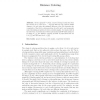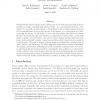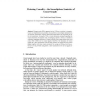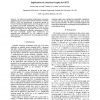554 search results - page 51 / 111 » Power Domination Problem in Graphs |
ESA
2007
Springer
14 years 1 months ago
2007
Springer
Given a graph G = (V, E), a (d, k)-coloring is a function from the vertices V to colors {1, 2, . . . , k} such that any two vertices within distance d of each other are assigned di...
RSEISP
2007
Springer
14 years 1 months ago
2007
Springer
The current research in granular computing is dominated by set-theoretic models such as rough sets and fuzzy sets. By recasting the existing studies in a wider context, we propose ...
FOCS
2009
IEEE
14 years 2 months ago
2009
IEEE
Polynomial time preprocessing to reduce instance size is one of the most commonly deployed heuristics to tackle computationally hard problems. In a parameterized problem, every in...
SG
2005
Springer
14 years 1 months ago
2005
Springer
Abstract. Bayesian nets (BNs) appeared in the 1980s as a solution to computational and representational problems encountered in knowledge representation of uncertain information. S...
ASPDAC
2005
ACM
13 years 9 months ago
2005
ACM
- We address the problem of implication of assertion graphs that occur in generalized symbolic trajectory evaluation (GSTE). GSTE has demonstrated its powerful capacity in formal v...




